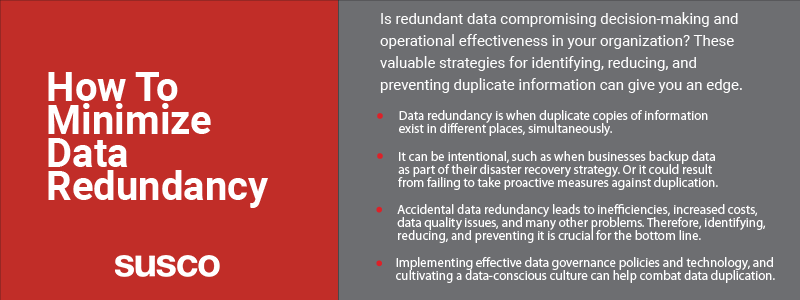Is redundant data compromising decision-making and operational effectiveness in your organization? These valuable strategies for identifying, reducing, and preventing duplicate information can give you an edge.

Modern organizations need to be wary of unintentional data redundancy and take proactive steps to eliminate it. Data redundancy is when multiple copies of the same information exist in more than one place at any given time—like when there’s duplicate customer data across departments’ separate systems. Naturally, this creates several issues, including:
- Slow data processes: Businesses must filter and unify duplicate data for accurate analysis. This involves manually sifting through data to find and consolidate repeated information or creating special code and schemas to automate deduplication. These added processes slow down data processing and analysis.
- Low-quality insights: Data redundancy creates inconsistent, corrupt, and unreliable datasets, leading to biased or irrelevant analysis and flawed decision-making.
- High storage costs: As more space is needed for multiple copies of the same information, storage and maintenance fees can quickly add up. This can be a considerable burden to boosting profits or reducing overhead.
- Missed opportunities: Businesses need fast insight to maximize opportunities. Analyses are less valuable when delayed. The result is lost opportunity and diminished ROI.
Given duplicate information’s impact on the bottom line, businesses must identify, understand, and proactively plan against it to stay competitive. This article provides practical data redundancy strategies that can improve data integrity, cost savings, and more reliable business insights.
Identifying the sources of data redundancy
Understanding how duplication occurs is the first step toward optimizing data management processes and maintaining data integrity. That said, these are the most common sources of data redundancy:
- Siloed systems: When systems operate independently and lack mechanisms for sharing data, there’s a high risk of creating and storing duplicate information across various departments or functions.
- Manual data entry: While human intervention is sometimes necessary, it increases the risk of errors. For example, employees may inadvertently input the same information multiple times or fail to update existing records accurately, exacerbating the problem of redundant data.
- Lack of standardized processes: Without standardized processes for data capture, storage, and maintenance, organizations are susceptible to duplicative efforts and discrepancies. For example, different teams may use varying naming conventions or data formats, making identifying and reconciling duplicate records challenging.
After determining the source of redundancy within your organization, it’s time to implement targeted strategies to mitigate the risks associated with duplicate data.
Implementing effective data governance policies
Implementing effective data governance policies is one of the best ways to eliminate redundancies. These provide clear guidelines and protocols for data usage, storage, and maintenance. They also define ownership, responsibilities, and access controls, helping maintain data consistency and accuracy across different departments and systems.
Uniform data management becomes easy with standardized definitions, formats, and classification schemes. This reduces redundancy and facilitates seamless integration and analysis, enhancing data-driven decision-making.
A comprehensive approach encompassing people, processes, and technology is needed to establish data governance policies, though. Therefore, organizations must define clear processes and workflows for data management, document them, and establish checkpoints for data quality assurance to identify and rectify data redundancy issues proactively. At the same time, they must designate data stewards to oversee implementation.
Leveraging technology to combat data duplication
Forward-thinking companies use data deduplication tools, integrated databases, and CRM systems to automatically identify and resolve data redundancies. You should, too.
Data deduplication tools use sophisticated algorithms to identify and eliminate duplicate entries within datasets before (inline deduplication) or after (post-process deduplication) storage. They analyze blocks or full copies of data within a file system to find repetitions and remove them while maintaining the original data.
On the other hand, integrated databases centralize data storage, allowing for seamless data access and real-time updates across various departments and systems. For example, a customer relationship management (CRM) system integrated with an enterprise resource planning (ERP) system keeps customer information consistent and up-to-date, eliminating the need for manual reconciliation and minimizing the risk of duplication.
Moreover, CRMs themselves offer robust features for managing and deduplicating customer data. With functionalities such as duplicate detection rules and merge capabilities, CRM platforms allow organizations to maintain a single source of truth for customer information.
Leveraging these technological solutions lets you automate identifying and resolving data redundancies, saving valuable time and resources. However, it’s essential to approach data deduplication strategically and continuously monitor data quality to ensure ongoing effectiveness. Fostering a culture where data quality is prioritized is also crucial.
Cultivating a data-conscious culture
If the pursuit of data quality isn’t already woven into your organizational ethos, a shift may be necessary to mitigate the risk of data redundancy. You’ll need to implement robust education and awareness initiatives to help the workforce understand how data redundancy impedes efficiency and their role in mitigating it. This includes comprehensive training on the technologies they’ll use to combat duplication.
Fostering a culture of collaboration and communication among different departments and stakeholders involved in data management is also crucial. Therefore, encourage interdisciplinary teams to work together to break down silos and promote a holistic approach to data governance.
Move towards a streamlined data management future with Susco
Accidental data redundancies create many challenges that affect the bottom line, including operational inefficiencies, increased costs, and data quality issues. So, it’s essential to remedy them before they impact business operations, hinder decision-making processes, skew analytics, and impede your organization’s ability to remain agile in a competitive landscape.
Identify whether it’s siloed systems, manual data entry, or lack of standardized processes that are the root cause, then build your strategy from there. Implementing effective data governance policies and technology and cultivating a data-conscious culture are excellent ways to combat data duplication.
Remember, continuous improvement in data management practices is crucial as the digital landscape evolves. Susco can help you move towards a streamlined data management future with custom AI, ML, and automation solutions. Contact us today to learn how to stay at the bleeding edge of technology.